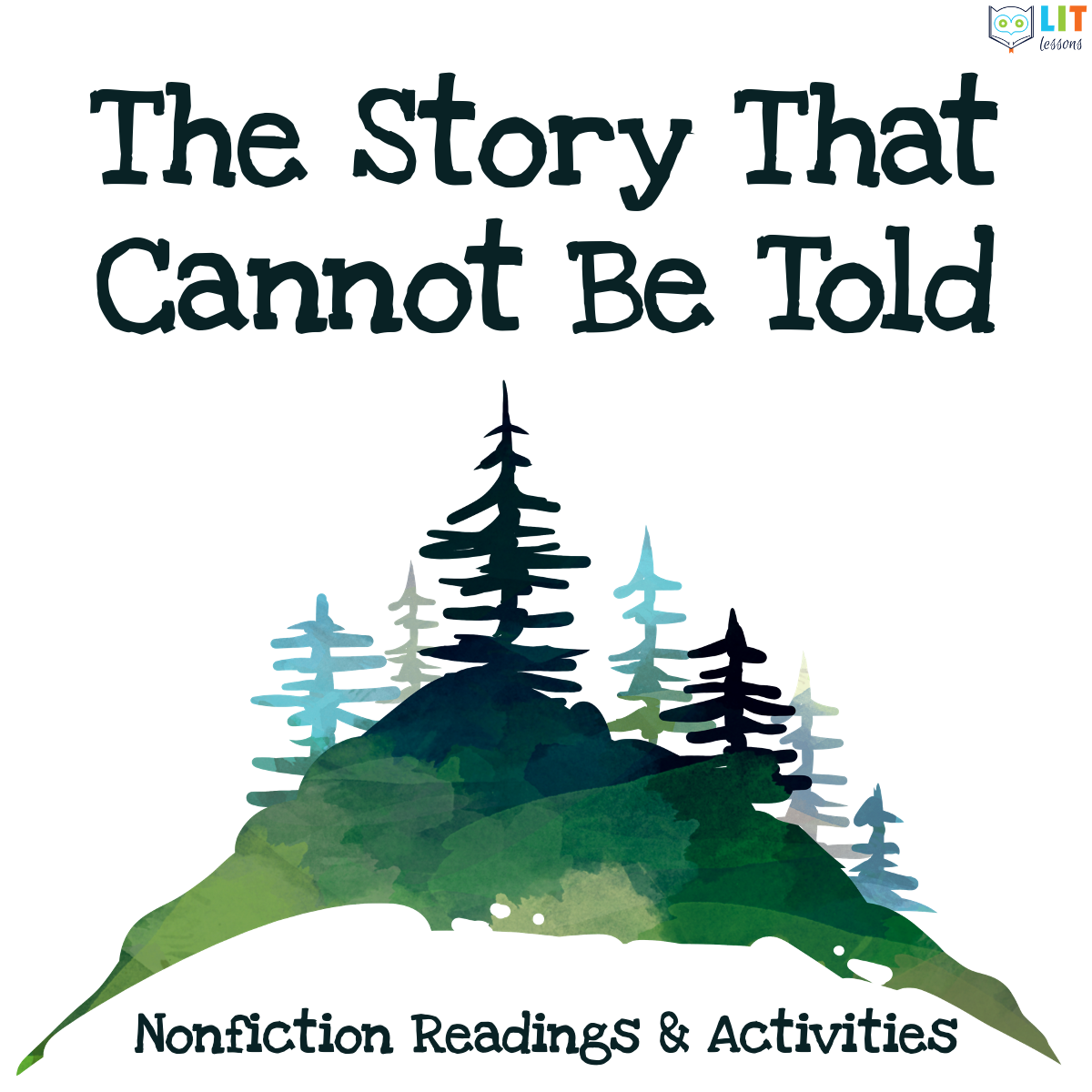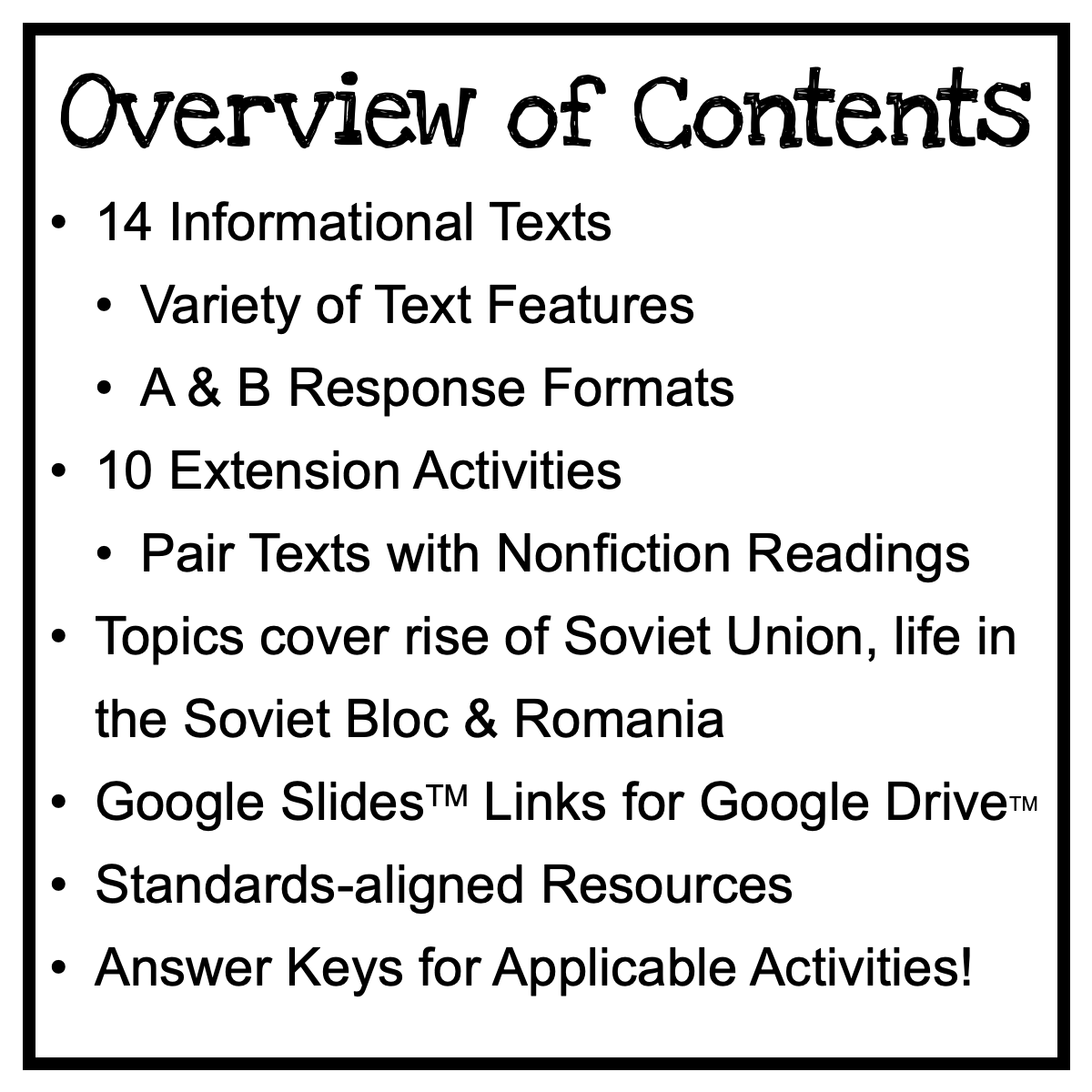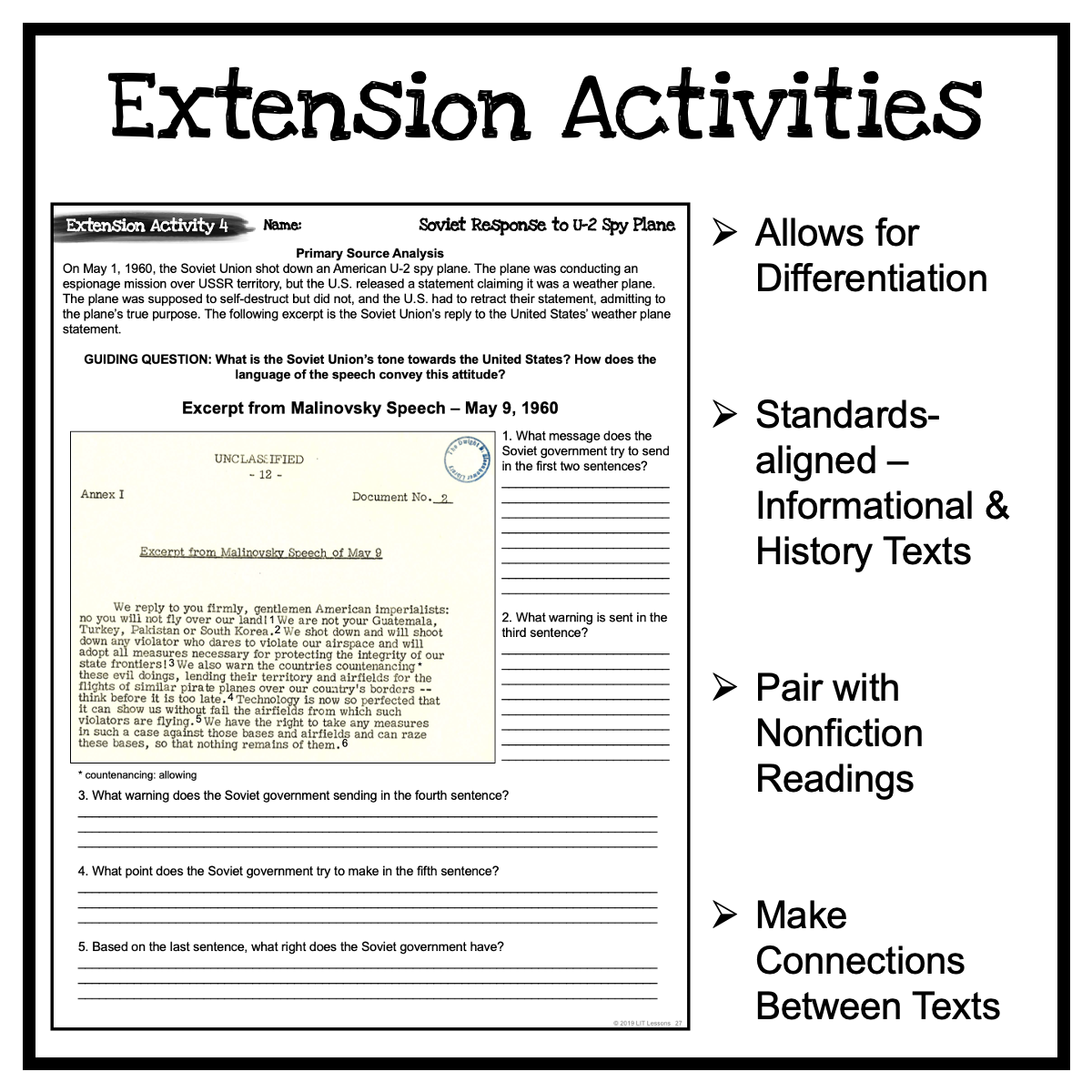The Story That Cannot Be Told History of Soviet Bloc Nonfiction Readings & Activities
You can only add to a wishlist if you have an account, please register now.
Create an Account$12
The Story That Cannot Be Told Nonfiction Connections – Snapshot of Included Resources:
- 14 Informational Texts
- Variety of Text Features
- A & B Response Formats
- 10 Extension Activities
- Pair Texts with Nonfiction Readings
- Topics cover rise of Soviet Union, life in the Soviet Bloc & Romania
- Google Slides™ Links for Google Drive™
- Standards-aligned Resources
- Answer Keys for Applicable Activities!
-
Communism & Its Rise
-
The Iron Curtain Descends
-
The Expansion of the Soviet Bloc
-
Case Study: Romania & the Soviet Bloc
-
New Leaders Lead to New Eras
-
Case Study: Nicolae Ceaușescu
-
Soviet Bloc Economy
-
Soviet Bloc Law Enforcement
-
Soviet Bloc Censorship & Propaganda
-
Soviet Bloc Society
-
Case Study: Life in Romania
-
Soviet Decline & Revolutions
-
Case Study: Romanian Revolution
-
The Collapse of Communism
-
Primary Source Analysis – Eliminating Dissent: Students will engage in a close reading of a memo on the publication of objectionable material in the Soviet Union. Students will analyze language to discern meaning, intent, and the values being conveyed as they consider the purpose of censoring information. They will also think critically about what the memo, as a historical artifact, reveals about life in the Soviet Union and the goals of the communist state.
-
Primary Source Analysis – Warsaw Pact: Students will engage in a close reading of the Warsaw Pact. Students will analyze language to discern meaning, intent, and the values being conveyed as they consider why the communist nations came together to create the alliance. They will also think critically about what the treaty, as a historical artifact, reveals about interactions between the West and the Soviet Bloc.
-
Socialist Realism in Art: For this extension activity, students will study art that captures the socialist realism style required by the communist state. As they examine the images, students will think critically about the purpose of the artwork, the messages and feelings it conveys, and what the art can reveal about life in the Soviet Union. *Requires Internet access.*
-
Primary Source Analysis – Soviet Response to U-2 Spy Plane: Students will engage in a close reading of an excerpt of a Soviet official’s speech about the United States explanation for the U-2 Spy Plane. Students will analyze language to discern meaning, intent, and the values being conveyed as they consider what the text demonstrates about tensions during that era. They will also think critically about what the event reveals about interactions between the United States government and the Soviet Union government.
-
Primary Source Analysis – Secret Police Report: For this extension activity, students will engage in a close reading of a KGB report about “hostile” materials and activity entering the Soviet Union. Students will analyze language to discern meaning, intent, and the values being conveyed as they consider the tactics used to suppress free thought. They will also think critically about what the report, as a historical artifact, reveals about purpose of the secret police and the atmosphere its work created in the Soviet Bloc.
-
Soviet Propaganda: Students will study four images that highlight the Soviet Union’s efforts to influence its people through images and messaging. As they examine the images, students will think critically about the purpose of the images, their messages, and what the propaganda can reveal about life in the Soviet Union. *Requires Internet access.*
-
Primary Source Analysis – U.S. International Broadcasting: For this primary source analysis, students will engage in a close reading of a national security directive about U.S. efforts to broadcast programs into the Soviet Bloc. Students will analyze language to discern meaning, intent, and the values being conveyed as they consider the United States role in providing access to information to the people living under communist rule. They will also think critically about what the directive reveals about the goals of the United States government during the Cold War.
-
Chuck Norris vs. Communism Documentary: In the documentary viewing, students will learn more about the importance and influence of VHS tapes in Romania towards the end of communist rule. The documentary also contains rich information about life in Romania and adds personal context to the living conditions endured under strict communist rule. *Documentary not included in this resource.* *Requires Internet access.*
-
Primary Source Analysis – “Trial” of the Ceaușescus: For the final primary source analysis, students will analyze the transcript of the Ceaușescus’ trial. They will gather evidence and evaluate the trial’s legitimacy based on their beliefs about what constitutes a fair trial. Then, students will write an argumentative essay explaining the fairness of the trial.
-
Historical Analysis of Novel – Essay: The essay sees students synthesizing the knowledge they have gained from the readings and activities with the novel, The Story That Cannot Be Told.
- ZIP file (PDFs and Word Docs for Digital Links)
- Non-Editable
- 41.32 MB
- 202 Pages
- Links for Student Pages in Google Slides™
- This downloadable resource supplies one single-teacher license for use in your classroom.
- Photocopying of this product is allowed only for the classroom use of the purchaser.
- Replication of this product, in whole or in part, for commercial sale or broader distribution is strictly prohibited.
- This product also may NOT be shared electronically, digitally, or otherwise in a manner that violates the Terms of Use detailed by LIT Lessons.
- For explicit information on permissions, please see the Terms of Use document included with this resource. Thank you for your cooperation and understanding.
The Story That Cannot Be Told Nonfiction Connections – Snapshot of Included Resources:
- 14 Informational Texts
- Variety of Text Features
- A & B Response Formats
- 10 Extension Activities
- Pair Texts with Nonfiction Readings
- Topics cover rise of Soviet Union, life in the Soviet Bloc & Romania
- Google Slides™ Links for Google Drive™
- Standards-aligned Resources
- Answer Keys for Applicable Activities!
-
Communism & Its Rise
-
The Iron Curtain Descends
-
The Expansion of the Soviet Bloc
-
Case Study: Romania & the Soviet Bloc
-
New Leaders Lead to New Eras
-
Case Study: Nicolae Ceaușescu
-
Soviet Bloc Economy
-
Soviet Bloc Law Enforcement
-
Soviet Bloc Censorship & Propaganda
-
Soviet Bloc Society
-
Case Study: Life in Romania
-
Soviet Decline & Revolutions
-
Case Study: Romanian Revolution
-
The Collapse of Communism
-
Primary Source Analysis – Eliminating Dissent: Students will engage in a close reading of a memo on the publication of objectionable material in the Soviet Union. Students will analyze language to discern meaning, intent, and the values being conveyed as they consider the purpose of censoring information. They will also think critically about what the memo, as a historical artifact, reveals about life in the Soviet Union and the goals of the communist state.
-
Primary Source Analysis – Warsaw Pact: Students will engage in a close reading of the Warsaw Pact. Students will analyze language to discern meaning, intent, and the values being conveyed as they consider why the communist nations came together to create the alliance. They will also think critically about what the treaty, as a historical artifact, reveals about interactions between the West and the Soviet Bloc.
-
Socialist Realism in Art: For this extension activity, students will study art that captures the socialist realism style required by the communist state. As they examine the images, students will think critically about the purpose of the artwork, the messages and feelings it conveys, and what the art can reveal about life in the Soviet Union. *Requires Internet access.*
-
Primary Source Analysis – Soviet Response to U-2 Spy Plane: Students will engage in a close reading of an excerpt of a Soviet official’s speech about the United States explanation for the U-2 Spy Plane. Students will analyze language to discern meaning, intent, and the values being conveyed as they consider what the text demonstrates about tensions during that era. They will also think critically about what the event reveals about interactions between the United States government and the Soviet Union government.
-
Primary Source Analysis – Secret Police Report: For this extension activity, students will engage in a close reading of a KGB report about “hostile” materials and activity entering the Soviet Union. Students will analyze language to discern meaning, intent, and the values being conveyed as they consider the tactics used to suppress free thought. They will also think critically about what the report, as a historical artifact, reveals about purpose of the secret police and the atmosphere its work created in the Soviet Bloc.
-
Soviet Propaganda: Students will study four images that highlight the Soviet Union’s efforts to influence its people through images and messaging. As they examine the images, students will think critically about the purpose of the images, their messages, and what the propaganda can reveal about life in the Soviet Union. *Requires Internet access.*
-
Primary Source Analysis – U.S. International Broadcasting: For this primary source analysis, students will engage in a close reading of a national security directive about U.S. efforts to broadcast programs into the Soviet Bloc. Students will analyze language to discern meaning, intent, and the values being conveyed as they consider the United States role in providing access to information to the people living under communist rule. They will also think critically about what the directive reveals about the goals of the United States government during the Cold War.
-
Chuck Norris vs. Communism Documentary: In the documentary viewing, students will learn more about the importance and influence of VHS tapes in Romania towards the end of communist rule. The documentary also contains rich information about life in Romania and adds personal context to the living conditions endured under strict communist rule. *Documentary not included in this resource.* *Requires Internet access.*
-
Primary Source Analysis – “Trial” of the Ceaușescus: For the final primary source analysis, students will analyze the transcript of the Ceaușescus’ trial. They will gather evidence and evaluate the trial’s legitimacy based on their beliefs about what constitutes a fair trial. Then, students will write an argumentative essay explaining the fairness of the trial.
-
Historical Analysis of Novel – Essay: The essay sees students synthesizing the knowledge they have gained from the readings and activities with the novel, The Story That Cannot Be Told.
- ZIP file (PDFs and Word Docs for Digital Links)
- Non-Editable
- 41.32 MB
- 202 Pages
- Links for Student Pages in Google Slides™
- This downloadable resource supplies one single-teacher license for use in your classroom.
- Photocopying of this product is allowed only for the classroom use of the purchaser.
- Replication of this product, in whole or in part, for commercial sale or broader distribution is strictly prohibited.
- This product also may NOT be shared electronically, digitally, or otherwise in a manner that violates the Terms of Use detailed by LIT Lessons.
- For explicit information on permissions, please see the Terms of Use document included with this resource. Thank you for your cooperation and understanding.



More The Story That Cannot Be Told Resources...
The Story That Cannot Be Told Novel Study
The Story That Cannot Be Told Novel Study is a comprehensive set of standards-aligned instructional materials for teaching The Story That Cannot Be Told by J. Kasper Kramer. With over 100+ materials, students will deeply engage with the novel and develop their literacy skills. The close reading activities, literary analysis resources, Soviet Bloc nonfiction readings and activities, vocabulary, assessments, and final project options all provide opportunities for your students to practice and apply what will be their growing understanding of the novel. They also provide numerous ways for you to DIFFERENTIATE learning for your students, allowing you to choose the assignments that best support your students’ learning while being conducive to any classroom model.
The Story That Cannot Be Told Chapter Questions
The comprehension guide and literary analysis resources provide a framework for students to deeply engage with every chapter grouping of The Story That Cannot Be Told. The 48 assignments – 24 comprehension and 24 literary analysis – are designed to not only to have students practice essential literary skills but also demonstrate their comprehension of the text. In having students demonstrate their understanding of the novel across both dimensions, the resource allows for differentiation and flexible implementation.
The Story That Cannot Be Told Close Readings
The 24 close reading lessons explicitly focus on critical Common Core State Standards to develop students’ literacy proficiency. Using The Story That Cannot Be Told as the foundational text for close reading, each lesson focuses on a particular skill, such as setting, conflict, tone, and plot, and provides students an opportunity to develop and demonstrate their ability to perform that skill. Each assignment also requires students to use textual evidence to support their claims. The resources could supply homework, facilitate guided reading groups, or stimulate whole class literacy discussions for each chapter grouping. You can choose the purpose that best suits your students and your classroom.
The Story That Cannot Be Told Assessments
The standards-aligned assessments will help you measure your students’ comprehension of The Story That Cannot Be Told and their ability to apply the literary skills taught throughout the unit. The materials include 24 reading checks, 3 novel quizzes, 3 final tests, and essay choice board.
The Story That Cannot Be Told Vocabulary
The vocabulary resources will engage students in varied activities to expand their vocabulary. The resources include materials to help teach challenging vocabulary words in The Story That Cannot Be Told that will then build your students’ vocabulary. With 6 vocabulary lists of 10 words each and a crossword puzzle, practice assignment, and quiz for each set, the materials provide opportunities for differentiation to suit the needs of the classroom.
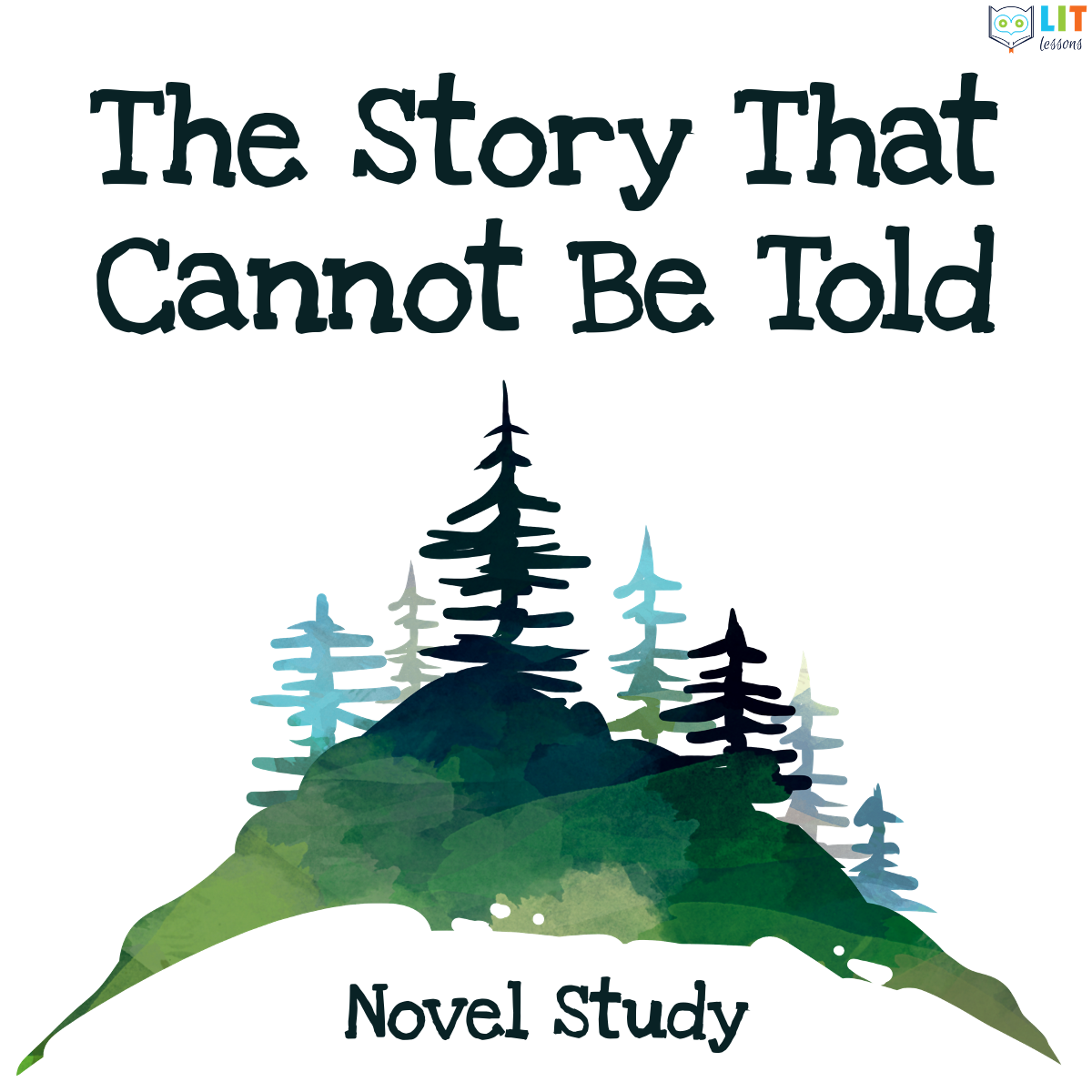
The Story That Cannot Be Told Novel Study
The Story That Cannot Be Told Novel Study is a comprehensive set of standards-aligned instructional materials for teaching The Story That Cannot Be Told by J. Kasper Kramer. With over 100+ materials, students will deeply engage with the novel and develop their literacy skills. The close reading activities, literary analysis resources, Soviet Bloc nonfiction readings and activities, vocabulary, assessments, and final project options all provide opportunities for your students to practice and apply what will be their growing understanding of the novel. They also provide numerous ways for you to DIFFERENTIATE learning for your students, allowing you to choose the assignments that best support your students’ learning while being conducive to any classroom model.

The Story That Cannot Be Told Chapter Questions
The comprehension guide and literary analysis resources provide a framework for students to deeply engage with every chapter grouping of The Story That Cannot Be Told. The 48 assignments – 24 comprehension and 24 literary analysis – are designed to not only to have students practice essential literary skills but also demonstrate their comprehension of the text. In having students demonstrate their understanding of the novel across both dimensions, the resource allows for differentiation and flexible implementation.
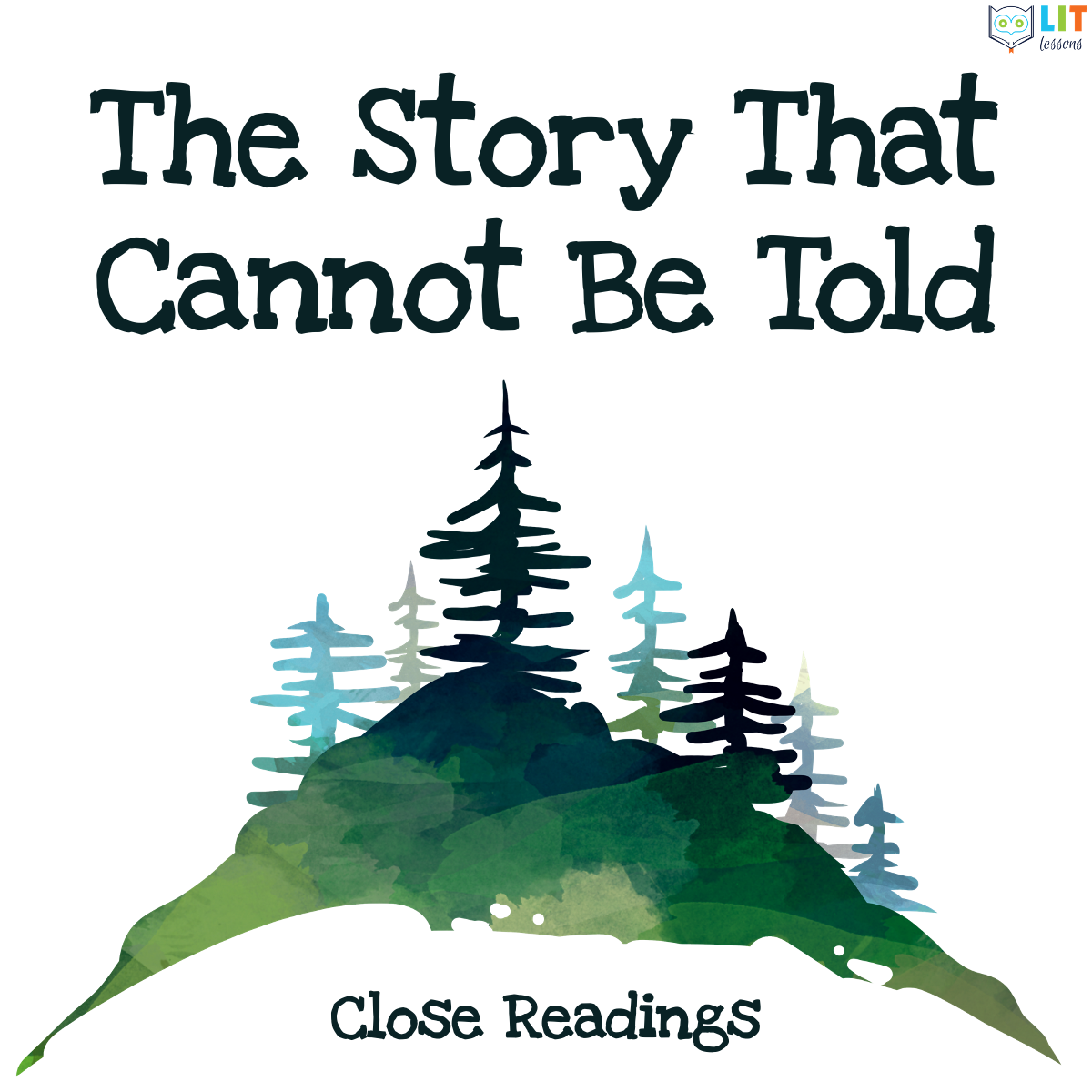
The Story That Cannot Be Told Close Readings
The 24 close reading lessons explicitly focus on critical Common Core State Standards to develop students’ literacy proficiency. Using The Story That Cannot Be Told as the foundational text for close reading, each lesson focuses on a particular skill, such as setting, conflict, tone, and plot, and provides students an opportunity to develop and demonstrate their ability to perform that skill. Each assignment also requires students to use textual evidence to support their claims. The resources could supply homework, facilitate guided reading groups, or stimulate whole class literacy discussions for each chapter grouping. You can choose the purpose that best suits your students and your classroom.

The Story That Cannot Be Told Assessments
The standards-aligned assessments will help you measure your students’ comprehension of The Story That Cannot Be Told and their ability to apply the literary skills taught throughout the unit. The materials include 24 reading checks, 3 novel quizzes, 3 final tests, and essay choice board.
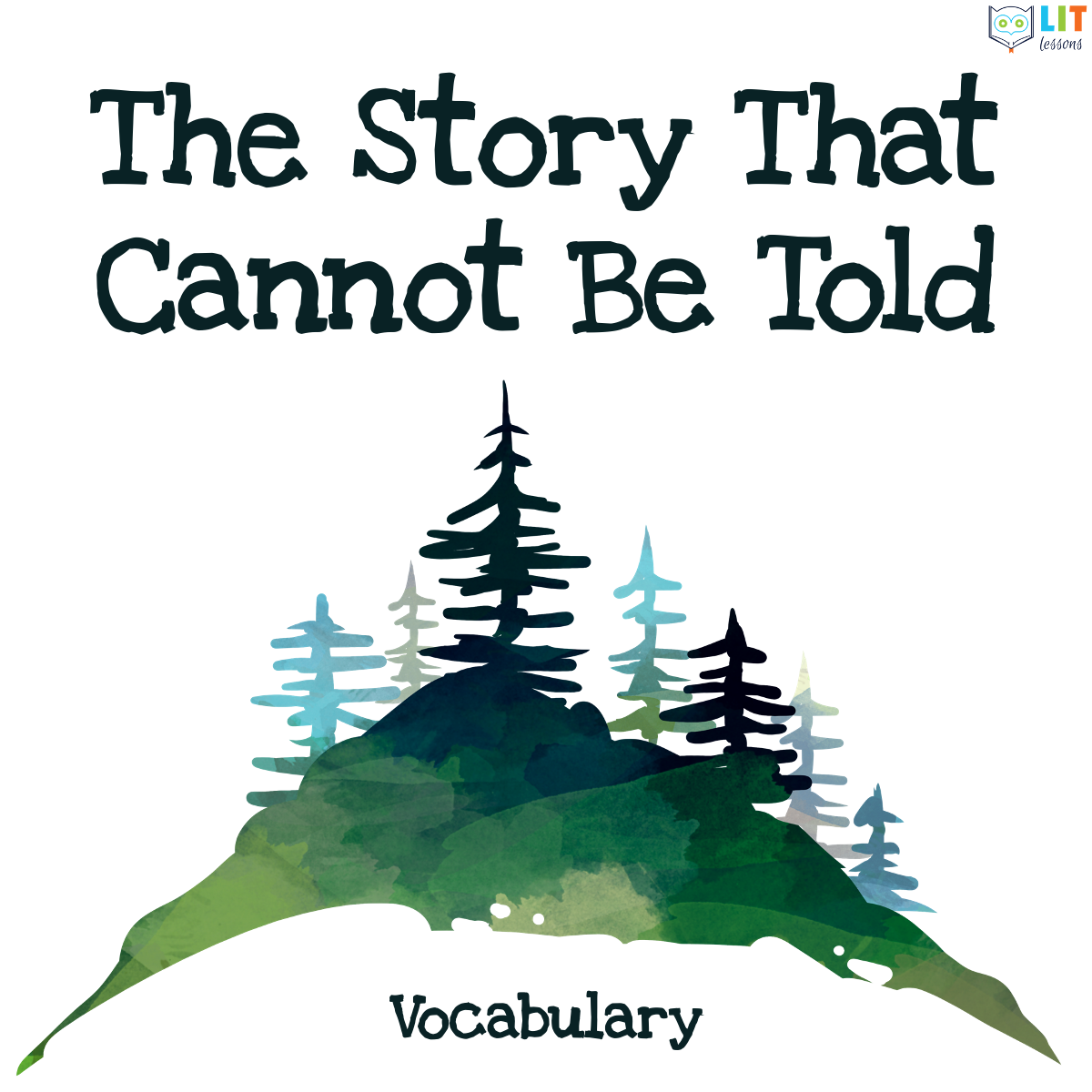
The Story That Cannot Be Told Vocabulary
The vocabulary resources will engage students in varied activities to expand their vocabulary. The resources include materials to help teach challenging vocabulary words in The Story That Cannot Be Told that will then build your students’ vocabulary. With 6 vocabulary lists of 10 words each and a crossword puzzle, practice assignment, and quiz for each set, the materials provide opportunities for differentiation to suit the needs of the classroom.

